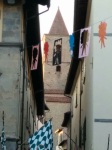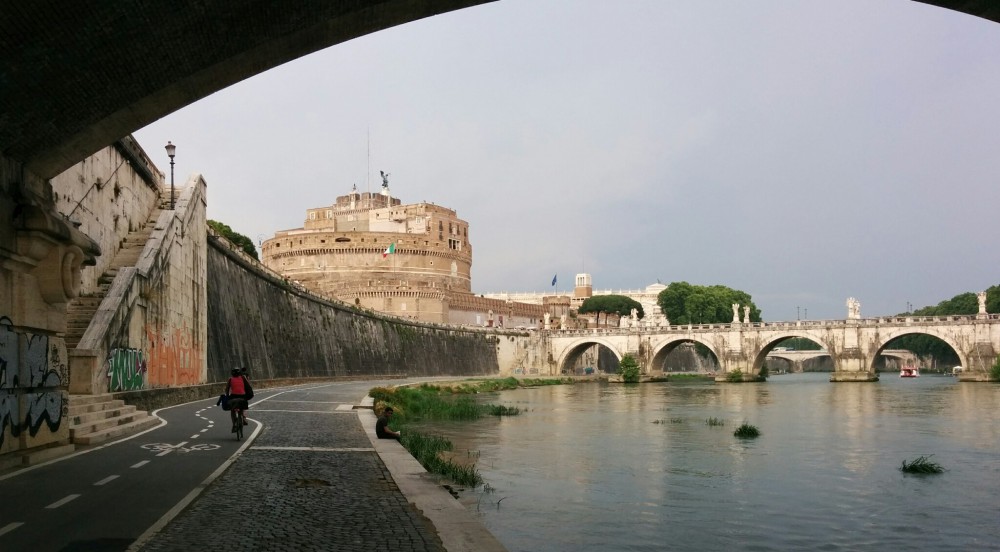 Back in the hotel Friday night (28 August), Cheryl saw a picture of the Gola del Furlo (the Gorge of the Furlo River). She wanted to ride there, and then go to Arezzo, which, according to her, was as interesting as Ravenna. Besides, I could go to Ravenna later, while I was riding up the Adriatic Coast. And we both wanted to go to places neither of us had seen.
Back in the hotel Friday night (28 August), Cheryl saw a picture of the Gola del Furlo (the Gorge of the Furlo River). She wanted to ride there, and then go to Arezzo, which, according to her, was as interesting as Ravenna. Besides, I could go to Ravenna later, while I was riding up the Adriatic Coast. And we both wanted to go to places neither of us had seen.
Saturday morning, we were on the train back down the coast to Fano. We figured an easy 30-40 km ride up a gentle slope on SP3 , take some pictures, and find a place to stay near there. Fano is a bicycle-friendly city, so soon we were in the country heading west. The SP3 turned out to be the ancient Via Flaminia. I recognized the old white milestones. On the seven main roads out of Rome (the famous “all roads lead to Rome” roads), the milestones indicate the distance to the Roman Forum. I liked knowing that we were only so far from Rome, no matter where we were. In fact, if pieces of the Flaminia had not been turned into autostrade, we could have ridden to the capital in less than three days from Fano.
 About two kilometers from the gorge, the road was closed, but not very convincingly. We rode around the concrete barrier, past the parked cars of picnicking families, and headed to the gorge. Suddenly, we found ourselves alone against a temporary wall constructed of chain-link fencing and plywood. Now the road was seriously closed, and we were very curious. We had come too far to let a simple construction barrier stop us, so I held the plywood door up to let Cheryl through, and then stepped through myself.
About two kilometers from the gorge, the road was closed, but not very convincingly. We rode around the concrete barrier, past the parked cars of picnicking families, and headed to the gorge. Suddenly, we found ourselves alone against a temporary wall constructed of chain-link fencing and plywood. Now the road was seriously closed, and we were very curious. We had come too far to let a simple construction barrier stop us, so I held the plywood door up to let Cheryl through, and then stepped through myself.
 The road was not just closed; it wasn’t there. The construction project sign on the plywood wall had understated the case. A landside at least 50 m wide had taken out the entire road and pushed it into the waters of the Gorge. From the state of the work, it was clear that the construction crews were actually cutting out more of the road and digging it down to give themselves a man-made, solid foundation on which to rebuild the road itself. Obviously, this project was not going to meet its published December deadline, and that it would be probably a couple of years before the via for me it was open again. Later, I learned that the landslide had occurred the winter before last.
The road was not just closed; it wasn’t there. The construction project sign on the plywood wall had understated the case. A landside at least 50 m wide had taken out the entire road and pushed it into the waters of the Gorge. From the state of the work, it was clear that the construction crews were actually cutting out more of the road and digging it down to give themselves a man-made, solid foundation on which to rebuild the road itself. Obviously, this project was not going to meet its published December deadline, and that it would be probably a couple of years before the via for me it was open again. Later, I learned that the landslide had occurred the winter before last.
Now we had a new problem. How do we get to the other side of the gap? There was a superstrada punching through a tunnel in the mountain above us, but it was forbidden to bicycles. I remembered passing a bus stop just before we got on the final road to the gorge. We rode back to the bus stop, and found that the bus should arrive shortly. It was our lucky day. The driver was obviously understood the problem and let us to pull our bicycles up into the bus and hang onto them while he went down to the superstrada, then sped through the tunnel.  Soon we were standing in the middle of Acqualagna, where the only accommodation was closed and for sale. We decided to ride back to the other side of the gap (about 7 km), and stay at the Antico Furlo, for which we had seen billboards along the road. The other side of the gap had the familiar plywood wall, but there was a pleasant park on that end of the gorge.
Soon we were standing in the middle of Acqualagna, where the only accommodation was closed and for sale. We decided to ride back to the other side of the gap (about 7 km), and stay at the Antico Furlo, for which we had seen billboards along the road. The other side of the gap had the familiar plywood wall, but there was a pleasant park on that end of the gorge.
 The Antico Furlo had more history than I expected. No surprise that it had been in operation for centuries, but I felt that I had entered a shrine to Benito Mussolini. Indeed, the Italian dictator praised the cooking at the Antico Furlo, coming back more than once. I can affirm that the place is clean, comfortable, and well-run – and the food is good.
The Antico Furlo had more history than I expected. No surprise that it had been in operation for centuries, but I felt that I had entered a shrine to Benito Mussolini. Indeed, the Italian dictator praised the cooking at the Antico Furlo, coming back more than once. I can affirm that the place is clean, comfortable, and well-run – and the food is good.
We had had quite an adventure for having ridden only 50 km all day.
 Sunday morning, we enjoyed the excellent breakfast at the hotel, and headed west. Our 1:200,000 map seemed to show a series of provincial roads that could take us across the Apennines without having to climb the sharp ridge that dominates the backbone of the country. We crossed a wide variety of terrains, from farmed plains near Acqualagna, through pine-covered slopes around Piobbico and Apecchio, along a windy ridge road, down to the industrial valley around Città di Castello. We rode in and out of the region of Umbria in just three hours. A pair of state highways took us into Tuscany and through a deep valley to the plain around Arezzo. The needle-like pines of the Tuscan wine-growing hills took over the scenery. It was not a fast ride (except for the downhill from the ridge to Città di Castello!), but we did not stop for lunch. We rode into Arezzo, 100 km from Furlo, before sunset.
Sunday morning, we enjoyed the excellent breakfast at the hotel, and headed west. Our 1:200,000 map seemed to show a series of provincial roads that could take us across the Apennines without having to climb the sharp ridge that dominates the backbone of the country. We crossed a wide variety of terrains, from farmed plains near Acqualagna, through pine-covered slopes around Piobbico and Apecchio, along a windy ridge road, down to the industrial valley around Città di Castello. We rode in and out of the region of Umbria in just three hours. A pair of state highways took us into Tuscany and through a deep valley to the plain around Arezzo. The needle-like pines of the Tuscan wine-growing hills took over the scenery. It was not a fast ride (except for the downhill from the ridge to Città di Castello!), but we did not stop for lunch. We rode into Arezzo, 100 km from Furlo, before sunset.
 Cheryl was right: Arezzo is a jewel. For my money, it was better than Siena and, for some things, better than Florence. The Piazza Grande looked like a construction zone, but the work was for the medieval jousting and other events that would take place after we left. The town was dripping with late Medieval and early Renaissance art. We were able to see Cimabue’s crucifix, and
Cheryl was right: Arezzo is a jewel. For my money, it was better than Siena and, for some things, better than Florence. The Piazza Grande looked like a construction zone, but the work was for the medieval jousting and other events that would take place after we left. The town was dripping with late Medieval and early Renaissance art. We were able to see Cimabue’s crucifix, and  Piero della Francesca’s frescoes, but the museums were closed. Cheryl had seen them, and I would return.
Piero della Francesca’s frescoes, but the museums were closed. Cheryl had seen them, and I would return.
Over dinner at the Piazza Grande, we modified our plan to ride to Florence the next day. Instead, we picked another town on our respective bucket lists: Cortona.
Until next week,
Smooth roads and tailwinds,
Jonathan.
